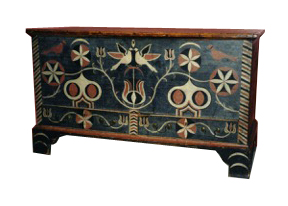
CRYSTAL RIVER, Fla. – Since my family has a long history in the American South – over 250 years – it seems natural that I would be drawn to Southern furniture. The question: where the heck is it? The answer is that a great deal of it is gone thanks to two destructive forces, the hot humid climate and Gen. William Tecumseh Sherman.
Granted you can find the odd “folk art” piece or the salvaged old farm table scattered around in small museums and shops, and a few families have well-preserved and equally well hidden family treasures that escaped the wrath of the Civil War, but where are the entire rooms on display or a series of chairs side by side to demonstrate the regional differences within the South?
I had long heard of the Museum of Early Southern Decorative Arts in Winston-Salem, N.C. It was under its aegis the masterful John Bivens produced his scholarly two-volume video titled Authenticating Antique Furniture in 1994 (excellent material impossible to find today). I finally had the chance to visit the museum in 2007 in the Old Salem district of Winston-Salem and was looking forward to an enjoyable a day or two cruising exhibits of Southern masterpieces. But that’s not the way it worked out.
Viewing the treasures of the museum is available only on 45 minute guided tours escorted by a volunteer docent who knows only the three sentences she has carefully memorized for each item. And the rooms are dark. The curator apparently has a fear of light damage to old surfaces so the rooms are dark, spot illuminated only by the flashlights operated by the docents. It was not a pleasant or especially educational adventure. But that was several years ago. I have since been informed by the museum that the situation has been greatly improved with docent education and careful lighting.
On the other hand I had the opportunity to visit the Colonial Williamsburg traveling exhibit of “Southern Furniture 1680-1830” when it was on display at the High Museum of Art in Atlanta. I was graciously given permission by both the Museum and Colonial Williamsburg to take photographs of the treasures displayed in that exhibit. Here are a few of my photographs of the extraordinary examples of real Southern furniture as displayed in the exhibit in Atlanta.
Low chair – The low chair (below) in front is from Maryland circa 1770 made of polar and oak. The low seat and splayed legs follow the form of Irish and Welsh cooking chairs of the old countries, perhaps a nostalgic reminder of home. The armchair is from North Carolina, circa 1750. The pattern is strongly suggestive of English chair design rather than American and may have been copied from an English chair or built by an English immigrant.
Carver chair – This chair (below) from southern Virginia, 1700-1750, made of ash and red cedar, it is one step ahead of the “Carver” chairs of the previous century named for John Carver, governor of the Plymouth colony. The maker of this chair had more resources than just a pole lathe as shown in the scrolled arms and flattened splats.
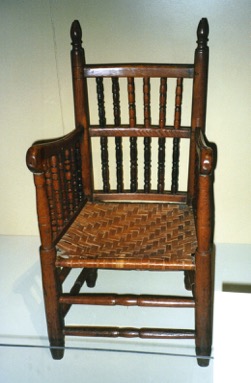
Desk – This desk from the Roanoke River Basin of northeastern North Carolina shows the Germanic influence. This desk is attributed to the “W.H.” cabinetmaker whose initials are inscribed in the prospect door. German influence was generally confined to the backwaters of the South but some areas of influence existed in the Chesapeake region.
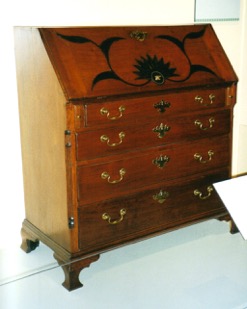
Blanket chest – Another example of German-Swiss influence can be seen in this early 19th-century Johannes Spitler chest from the Shenandoah Valley in Virginia. Large groups of German-Swiss settlers left Pennsylvania to go further south into Maryland, Virginia and Tennessee, living in isolated settlements in the back country preserving their native art and culture.

Federal chest – More upscale furnishings were found a little to the north. This Federal period chest is from Baltimore, circa 1795-1810, made of mahogany, tulip poplar, white pine, yellow pine, satinwood, maple and rosewood. By 1800 Baltimore was the fifth largest city in the country and supported a large population of artisans and cabinetmakers. With such rapid growth cabinet making traditions were less codified and Baltimore cabinetmakers of the period tended to be more experimental in their designs.
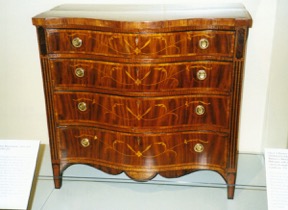
Side chairs – These two chairs show the similarities and differences of the same style in different cities. Note the shapes of the splat. The chair on the left is from Georgetown (Washington, D.C.) made of walnut and yellow pine, 1755-1779. The chair on the right is from Philadelphia from the same period.

Secretary – From the Coastal South of the Upper Potomac River Valley is this bookcase/secretary by Charles Cameron, Shepherdstown, Virginia (now West Virginia), circa 1805-1815. It is made of mahogany, cherry, tulip poplar, yellow pine and sumac. A Federal cherry and mahogany chest of drawers signed “Charles P. Cameron, Shepherdstown, July 27, 1808” was advertised in the magazine Antiques in the July 1978 issue.
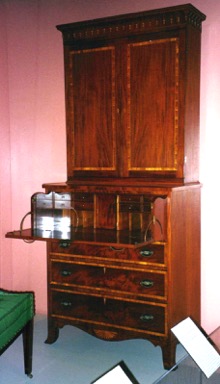
As it turns out, Southern furniture is a lot like its people – part of the Great American nation but with its own quaint flourishes.
___
By FRED TAYLOR
Send comments, questions and pictures to Fred Taylor at P.O. Box 215, Crystal River, FL 34423 or email them to him at info@furnituredetective.com. Visit Fred’s newly redesigned website at www.furnituredetective.com and check out the new downloadable “Common Sense Antiques” columns in .pdf format.
His book “How To Be a Furniture Detective” is available for $18.95 plus $3 shipping. Send check or money order for $21.95 to Fred Taylor, P.O. Box 215, Crystal River, FL, 34423.
Fred and Gail Taylor’s DVD, “Identification of Older & Antique Furniture” ($17 + $3 S&H) is also available at the same address. For more information call 800-387-6377 (9 a.m.-4 p.m. Eastern, M-F only), fax 352-563-2916, or info@furnituredetective.com. All items are also available directly from his website.



